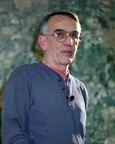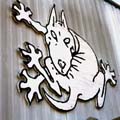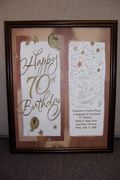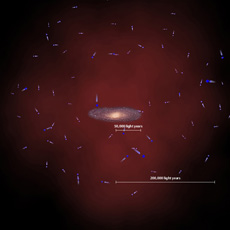|
Information on the furloughs at Fermilab, which stopped May 31, 2008, is available on the furlough Web pages.
|
|
Friday, June 13
3:30 p.m.
DIRECTOR'S COFFEE BREAK - 2nd Flr X-Over
4 p.m.
Joint Experimental-Theoretical Physics Seminar - One West
Speaker: H. Ray, University of Florida
Title: Testing the Compatibility of MiniBooNE and Other High Dm2 Oscillation Searches
Monday, June 16
2:30 p.m.
Particle Astrophysics Seminar - Curia II
Speaker: K. Martens, University of Utah
Title: Cosmic Rays in Utah: From HiRes to Telescope Array
3:30 p.m.
DIRECTOR'S COFFEE BREAK - 2nd Flr X-Over
4 p.m.
All Experimenters' Meeting - Curia II
Special Topic: Dark Energy Survey
Click here for NALCAL,
a weekly calendar with links to additional information. |
Friday, June 13
- New England clam chowder
- Black & blue cheese burger
- Mardi Gras jambalaya
- Smart cuisine: Dijon meatballs over noodles
- Bistro chicken & provolone panini
- Assorted sliced pizza
- *Carved top round of beef
*Carb Restricted Alternative
Wilson Hall Cafe Menu |
|
Wednesday, June 18
Lunch
- Assortment of quiches
- Salad of field greens with raspberry vinaigrette
- Apple walnut cake w/ cream Chantilly
Thursday, June 19
Dinner
- Melon & prosciutto
- Grilled duck breast w/ zinfandel fig sauce
- Wild rice w/ pecans and currants
- Sautéed green beans
- Lemon napoleons
Chez Leon Menu
Call x4598 to make your reservation. |
|
|
DZero founder turns 7-Zero,
to accolades
 |
| Paul Grannis |
While SUNY professor Paul Grannis has had a substantial impact on particle physics as a whole, he has a special connection to Fermilab.
Last week, DZero collaborators sent Grannis a detector-engraved plaque and a 2-by-3-foot postcard to show their appreciation and to honor his 70th birthday.
"Paul's dynamic leadership of DZero from conception to the important science
results from Run I brought both the detector and the collaboration to the
top level of worldwide particle physics," said former Fermilab Director John Peoples. "He was a joy to work with."
 |
| DZero's dog logo was designed by Grannis's neighbor, New Yorker cartoonist George Booth. |
Former Fermilab Director Leon Lederman appointed Grannis in 1983 to organize a team and proposal to create a second detector on the Tevatron ring. Grannis helped with the original detector design, Run II upgrade plans and led the collaboration as spokesman through 1996. At his request, Grannis' neighbor New Yorker cartoonist George Booth designed the collaboration's dog logo, which later was incorporated with the detector's location on the ring to create the name DZero. During his tenure as spokesman, the collaboration announced several key results including the top quark discovery. In the late 1990s, along with Roy Rubenstein, he led the push to lift national sanctions hindering participation by collaborators from India.
Grannis also worked on the Pisa-Stony Brook experiment at CERN's ISR; helped organize the Circle Line lecture series to consider a next-generation linear collider; and, as a DOE representative, first reviewed the ILC America's plan in 2006.
 |
| Birthday card sent to Paul Grannis at SUNY. |
Dan Green, CMS collaboration chair, who speaks at a SUNY symposium today in Grannis' honor, called working with Grannis as a postdoc and at CERN a "terrific experience."
At Fermilab, Green sees Grannis' mark.
"Paul led the effort to create the DZero collaboration and was the spokesperson of DZero from conception through first data and culminating in the top quark discovery," Green said. "Clearly, Paul has been a huge figure in the scientific life of Fermilab."
-- Tona Kunz
|
Would an antimatter apple fall up?
From New Scientist, June 12, 2008
New experiments are being proposed to test a big unknown in physics: how antimatter reacts to gravity.
Physicists have studied antimatter, the mirror version of ordinary matter, for decades. They know, for example, that antiparticles have the same mass as ordinary particles, but opposite charge. But no one knows what effect gravity will have on such particles.
Now several groups want to measure exactly how the Earth will pull on antimatter. The tests would create a horizontal beam of the stuff and measure how much gravity deflects it.
The complicated ballistic test may show no difference between the way matter and antimatter fall. But some experimentalists are holding out hope that they may see something completely unexpected, which could point the way to new gravity-like forces, or perhaps even antigravity.
"If antimatter fell down faster, it would mean the discovery of at least one new force, probably two. If it fell up, it would mean our understanding of general relativity is incorrect," says Thomas Phillips, a physicist at Duke University in Durham, North Carolina, US.
Repulsive force
Gravity is largely expected to have the same effect on antimatter as it does on matter. But theories of quantum gravity, which attempt to unite quantum mechanics and general relativity, allow for the possibility of two other gravity-like forces.
Read more
|
|
|
A slimmer Milky Way

Image courtesy of SDSS Collaboration, Axel Quetz, Max Planck Institute for Astrophysics, Heidelberg
The Milky Way galaxy has lost weight. About a trillion suns' worth.
A more accurate scale rather than a galactic diet accounted for the recent slimming. This weighty discovery from the Sloan Digital Sky Survey (SDSS-II ) has broad implications for our understanding of the Milky Way.
"The galaxy is slimmer than we thought," said Xiangxiang Xue of the National Astronomical Observatories of China, who led an international team of researchers. "That means it has less dark matter than previously believed, and that it was more efficient in converting its original supply of hydrogen and helium into stars."
The discovery, accepted for publication in The Astrophysical Journal, is based on data from SEGUE, an enormous survey of stars in the Milky Way-one of the three programs that comprise SDSS-II. Using SEGUE measurements of stellar velocities in the outer Milky Way, a region known as the stellar halo, the researchers determined the mass of the Galaxy by inferring the amount of gravity required to keep the stars in orbit. Some of that gravity comes from the Milky Way stars themselves, but most of it comes from an extended distribution of invisible dark matter, whose nature is still not fully understood.
Read more
|
Voluntary layoff information
This week Kay Van Vreede, the head of the Fermilab Workforce Development and
Resources Section, sent e-mails with information on the Voluntary Self Select
Option Program to 750 employees. To make sure that employees who are part of the VSSOP did receive
their offers, WDRS asks these employees to confirm the receipt of these
e-mails if they haven't already done so. If you use an e-mail reader that
allows for Read Receipts, you can acknowledge the receipt by clicking on the
OK button of the pop-up message. Otherwise, please reply to the e-mail you received with the subject line "Voluntary Self Select Option
Plan" or send an e-mail to wdrs_voluntary@fnal.gov. Employees who
received the offer and who would like to take voluntary separation need to
apply before 5:30 p.m. on June 20.
|
|
Have a safe day!
Career decision-making seminar available June 13, 18
For those eligible for the voluntary layoff program, please consider attending a Career Decision Making seminar conducted by the career transition firm Lee Hecht Harrison. Register for sessions at 1 p.m. today or at 8:30 a.m. and 1 p.m. on June 18. Questions? Send e-mail to wdrs_voluntary@fnal.gov.
Blood drive June 24, 25
Heartland Blood Centers will conduct a Fermilab Blood Drive on June 24 and 25 from 8:30 a.m to 2 p.m. in the Wilson Hall Ground
Floor NE Training Room. Schedule appointments online or call Diana at x3771 or Margie at x5680. More information.
The last blood drive collected 83 units. Many thanks to all who donated.
Going to CERN?
Take your camera! Have your photos featured in the Fermilab Remote
Operations Center online gallery. Contact Elizabeth Clements for details.
Special discount on SciTech
summer camps
The SciTech hands-on Children's Museum in Aurora offers all Fermilab
employees discounts on its Science Adventure summer camps, honoring the
long-standing relationship between the two organizations. The week-long
camps begin on June 23 and run from 9 a.m. to 3 p.m. with before and after
care available from 8 a.m. to 5 p.m. Fermilab employees only pay from $174
to $199 and the before and after care is free. Visit the SciTech Web site to register. (Do not use the Web
site to sign up for before and after care. SciTech will call you to confirm
whether you want this service.) To receive your discount enter the code
FERMI2008 on checkout.
Fermilab pool opening
Fermilab's directorate is working with a pool committee to open the Fermilab pool this summer. The committee members hope to have the pool open by the end of June. Additional details will be published in Fermilab Today and in an e-mail sent to the Fermilab Users.
Classifieds
Find new classified ads on Fermilab Today.
Additional Activities
|
|